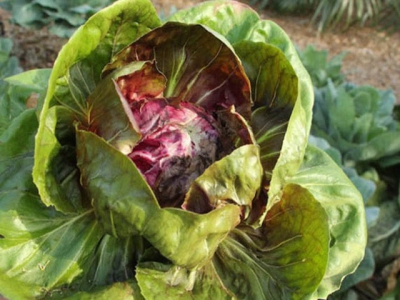Bacterial diseases of lettuce

There are two fairly common bacterial diseases of lettuce that most lettuce growers will come across from time to time:
Bacterial spot
Xanthomonas campestris is mainly a problem in late summer, as cooler conditions favour the development of this disease. The optimum temperature is 22°C to 23°C, and it takes just one cool rainy spell to cause an outbreak.
Bacterial spot manifests as water-soaked lesions on mainly older leaves. These develop into irregular brown to dark-brown blotches or spots with a lighter border. The level of infection will depend on the persistence of favourable weather. In most cases, it affects lettuce quality more than it restricts growth. Trim off the unsightly leaves when preparing lettuce for pre-packs.
When symptoms begin appearing on the lower leaves, thoroughly spray a copper-based product on the plant, trying to get a good soaking under the leaves. Unfortunately, this is virtually impossible with the lower leaves that touch the ground, and it is on these leaves that infection starts. You should therefore try to halt the spread of the disease before it renders the plant unmarketable.
Base your spraying frequency on the weather forecast. If the disease started during a cool, rainy patch and warmer weather is predicted, less spraying should be required. You may have to be proactive if colder weather is predicted, and spray even before the symptoms appear. A useful tip: plant varieties with higher resistance during high-risk periods.
Bacterial soft rot
Pectobacterium carotovorum affects a number of different crops and is associated with moist conditions and injury to the plant. As its common name implies, the disease causes a soft, slimy, smelly brownish rot on infected areas. It is often found on the head of lettuce, usually starting on one side and then spreading.
It may go unnoticed until the leaves are removed, and is common in lettuce that has been stored for a few days. It can spread very rapidly when conditions are favourable. It does not take much injury to trigger the infection in humid conditions. Even thrip damage can start it off.
As with other bacterial diseases, the only practical remedy is to spray a copper-based product as a preventative measure when the disease is likely to occur. In particular, it should be done immediately after hail damage – on the same day if possible.
Varnish spot
I have come across Pseudomonas cichorii only once, as the conditions must be just right for the disease to occur. It is caused by soil-dwelling bacteria that enter the plant at the late rosette stage through rain splash or irrigation.
The symptoms make the leaves look as if they have been varnished and can be seen when the cover leaves are removed. It is unlikely that this disease will become a regular problem. If it threatens to do so, apply a copper spray just before the leaves start to form a head.
Có thể bạn quan tâm
Phần mềm

Phối trộn thức ăn chăn nuôi

Pha dung dịch thủy canh

Định mức cho tôm ăn

Phối trộn phân bón NPK

Xác định tỷ lệ tôm sống

Chuyển đổi đơn vị phân bón

Xác định công suất sục khí

Chuyển đổi đơn vị tôm

Tính diện tích nhà kính

Tính thể tích ao hồ



 Integrated pest management system
Integrated pest management system  Fungal diseases of lettuce
Fungal diseases of lettuce